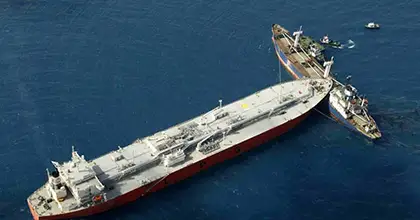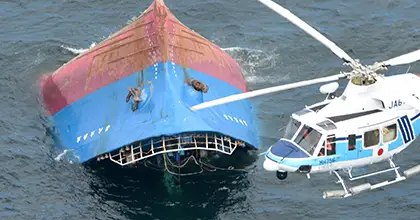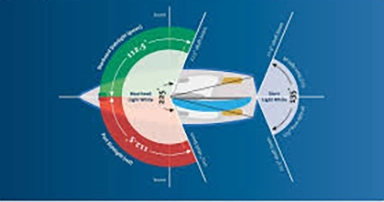Whether you’re navigating a sailboat, powerboat, or any other type of vessel, avoiding collisions is paramount for safety on the water. As such, it is essential that boat operators know how to deal with situations appropriately. Understanding and adhering to the International Regulations for Preventing Collisions at Sea (IRPCS), also known as COLREGs, is therefore essential. These regulations provide a comprehensive set of guidelines to ensure safe navigation and prevent accidents. We’ll look at how to implement them, but also some common sense tips for various situations.
Understanding Large Commercial Shipping
Large commercial ships are a common sight for any boater and you need to know how to share the water with them safely. They may seem slow and cumbersome, but don’t be deceived. Here’s what you need to know.

Watch Out for Their Speed
Don’t underestimate how quickly a large ship can move. Even at manoeuvring speeds (around 12-15 knots), they cover a lot of ground fast. In clear weather, a ship might be on you within 10 minutes of spotting it. In low visibility, that time shrinks dramatically. Remember, at 10 knots, a ship travels a nautical mile in just 6 minutes.
Stay Clear of Narrow Channels
Large ships have limited maneuverability, especially in narrow channels. The channel itself might not always be well-defined, so it’s crucial to give them plenty of space. They can’t easily swerve to avoid smaller vessels like yours – and likely won’t.
Understand their Stopping Distance
Stopping a large ship takes time and distance, sometimes a mile or more. A slowing ship also loses steering control because its rudder needs water flow to work. If they reverse their engines, their steering becomes even more unpredictable.
Use Common Sense & Courtesy
Stay out of the way of large commercial vessels to avoid collisions. Please – don’t be the fool who insists on being the stand on vessel and forcing them to alter course for you.
Other Commercial Hazards
Be aware of smaller vessels too. Tugs towing barges can be difficult to see at night, especially if the barges are poorly lit. Remember, a towing cable can be a serious danger if it’s partially submerged. Commercial fishing vessels, while more maneuverable, are a collision nightmare. Just when you think you’ve understood their course, they’ll swing round and give you a heart attack. They are going to be the stand on vessel when it comes to you, so just give them a wide berth and keep out of their way.

The Key Maneuvers
Power gives way to sail (but see above). For power driven vessels, pass port to port. If crossing, give way to a vessel coming from your starboard side. If overtaking, give plenty of space until you are well past. If two or more sailing vessels sailing, port tack gives way to starboard tack. If you can’t tell what tack they’re on, presume they’re on starboard tack. If you are both on the same tack, the downwind vessel is the stand on vessel. Big turns are far easier to understand than a change in speed. For power. driven vessels, there’s an old saying that will stand you in good stead, “If you’re going to go down, go down with your wheel hard to starboard.”
General Good practice
Keep a constant lookout
Maintaining situational awareness is all important. Keep well aware of other boats and navigational hazards in front of you, behind you and to each side.
Stay out of the way of commercial vessels
Avoid sailing or motoring in ship channels, especially if visibility is poor because of fog, rain or darkness. Big ships must stay in the deep channels, and most smaller vessels don’t need to. No matter how fast your boat, it is best to pass well astern of a ship or barge. Remember, no boat has ever sunk by passing behind a moving ship.
Be visible
At night, make sure that your navigation lights are bright and are not obscured by sails, flags or dinghies in davits. If you see the running lights of a vessel and you don’t think you have been seen, begin to get out of the way, using flashlights on sails, a spot-light, flash bulbs, or a white flare to indicate your position. Carry a radar reflector as high on the boat as you can or even better an electronic See-Me.
Moinitor AIS but don’t rely on it
Probably oneof the best investments you can make, an Automatic Identification System (AIS) receiver/transmitter in not a legal requirement for most leisure craft, but I would not want to go sea these days without one. It will tell you who’s around and how close they’re going to get to you. BUt not all boats have it and AIS data can sometimes be inaccurate or incomplete due to signal loss, equipment failure. Read our full article on AIS here.
Know your lights
You don’t need to know many, but you do need to know some and in good detail. A power driven vessel will have a white steaming light (facing forward), a white stern light (facing aft) and a green light on starboard and a red light on port. Want ways to remember port and starboard? Read this. If the vessel is over 50 meters, it will have two white steaming lights, with the forward one being lower. (It makes it wonderfully easy to see the heading of the vessel).

Know the sound signals
Sound signals are used all the times by commercial vessels and by all vessels in limited visibility. They help to clarify a boat’s intentions. One short blast indicates a vessel is altering its course to starboard (right), while two short blasts signal a turn to port (left). Three short blasts signify that a vessel is operating astern propulsion, essentially moving or about to move backward.If you hear five or more short blasts on the whistle, it is the “danger” signal. Check and see if it is for you and if it is, make way fast.
Monitor your VHF
If you have a VHF radio aboard, remember that while channel 16 is the calling and distress frequency, channel 13 is the working frequency used to arrange safe meeting and passing between commercial ships. ships and other watercraft. Do not use your VHF for collision avoidance except in close quarters when reaction times are limited. Make it absolutely clear who you are, where you are and to whom you are speaking. In all other situations, the colregs tell you exactly what to do and use of VHF is a prime cause of confusion.
Use binoculars
At night especially they can help you determine ships’ lights and direction with greater accuracy. Get into the habit of sweeping the horizon 360 degrees at least every fifteen minutes, more frequently in poor conditions, even if can’t see anything, and yes that includes at night!
Understanding the Basics of the IRPCS
The IRPCS are divided into several parts, with Part B (Steering and Sailing Rules) and Part C (Lights and Shapes) being the most relevant for collision avoidance. Here’s a guide to the key rules
Maintain a Proper Lookout (Rule 5)
Always keep a vigilant lookout by sight, hearing, and all available means appropriate to the prevailing circumstances and conditions. This helps to make a full appraisal of the situation and the risk of collision. Track the bearing of any ships where the risk of collision may exist.
Safe Speed (Rule 6)
Travel at a safe speed so that you can take proper and effective action to avoid a collision and be stopped within a distance appropriate to the prevailing circumstances.
Risk of Collision (Rule 7)
Use all available means to determine if a risk of collision exists. If there is any doubt, assume that a risk exists.
Action to Avoid Collision (Rule 8)
Take timely and substantial action to avoid a collision. Make sure your actions are large enough to be obvious to other vessels..
Narrow Channels (Rule 9)
Keep as near to the outer limit of the channel which lies on your starboard side as is safe and practicable.
Traffic Separation Schemes (Rule 10)
Do not use a TSS unless you are a large vessel. Stay outside it unless you have to enter it. Avoid crossing them if possible, but if you have to, do so at 90° to the direction of traffic. All other rules apply as normal.
Summary
What should you do to avoid colliding with another vessel? Pay attention to the navigation rules and traffic patterns in busy areas. Understand and adhere to the IRPCS, maintain a vigilant lookout for other boats, maintain a safe speed, and take decisive action when necessary. Be aware that floating debris is more common after heavy rainfall. Never operate your vessel when fatigued, stressed, or consuming alcohol as these often play a role when a collision occurs. By following this guide, you can significantly reduce the risk of collisions. These skills are essential for anyone looking to take the RYA Day Skipper, Yachtmaster or ASA courses. Continuous learning using an experienced sailing instructor and practical experience will further enhance your ability to navigate safely, allowing you to enjoy your time on the water with confidence.